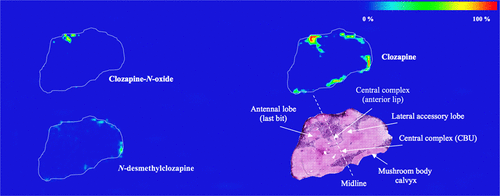当前位置:
X-MOL 学术
›
ACS Chem. Neurosci.
›
论文详情
Our official English website, www.x-mol.net, welcomes your
feedback! (Note: you will need to create a separate account there.)
Evaluation of Drug Exposure and Metabolism in Locust and Zebrafish Brains Using Mass Spectrometry Imaging
ACS Chemical Neuroscience ( IF 4.1 ) Pub Date : 2018-01-19 00:00:00 , DOI: 10.1021/acschemneuro.7b00459 Marvin Villacrez 1 , Karin Hellman 1 , Tatsuya Ono 2 , Yutaka Sugihara 2 , Melinda Rezeli 2 , Fredrik Ek 1 , Gyorgy Marko-Varga 2 , Roger Olsson 1
ACS Chemical Neuroscience ( IF 4.1 ) Pub Date : 2018-01-19 00:00:00 , DOI: 10.1021/acschemneuro.7b00459 Marvin Villacrez 1 , Karin Hellman 1 , Tatsuya Ono 2 , Yutaka Sugihara 2 , Melinda Rezeli 2 , Fredrik Ek 1 , Gyorgy Marko-Varga 2 , Roger Olsson 1
Affiliation

|
Studying how and where drugs are metabolized in the brain is challenging. In an entire organism, peripheral metabolism produces many of the same metabolites as those in the brain, and many of these metabolites can cross the blood-brain barrier from the periphery, thus making the relative contributions of hepatic and brain metabolism difficult to study in vivo. In addition, drugs and metabolites contained in ventricles and in the residual blood of capillaries in the brain may overestimate drugs’ and metabolites’ concentrations in the brain. In this study, we examine locusts and zebrafish using matrix assisted laser desorption ionization mass spectrometry imaging to study brain metabolism and distribution. These animal models are cost-effective and ethically sound for initial drug development studies.
中文翻译:

质谱成像评估蝗虫和斑马鱼大脑中的药物暴露和代谢
研究药物在大脑中的代谢方式和位置具有挑战性。在整个生物体内,外周代谢产生的代谢产物与大脑中的代谢产物相同,并且许多此类代谢产物可以从外周穿过血脑屏障,因此,肝脏和脑代谢的相对贡献很难在体内进行研究。 。此外,脑室和毛细血管残留血液中所含的药物和代谢物可能会高估大脑中药物和代谢物的浓度。在这项研究中,我们使用矩阵辅助激光解吸电离质谱成像技术研究大脑的代谢和分布,从而研究了蝗虫和斑马鱼。这些动物模型在最初的药物开发研究中具有成本效益且在伦理上合理。
更新日期:2018-01-19
中文翻译:

质谱成像评估蝗虫和斑马鱼大脑中的药物暴露和代谢
研究药物在大脑中的代谢方式和位置具有挑战性。在整个生物体内,外周代谢产生的代谢产物与大脑中的代谢产物相同,并且许多此类代谢产物可以从外周穿过血脑屏障,因此,肝脏和脑代谢的相对贡献很难在体内进行研究。 。此外,脑室和毛细血管残留血液中所含的药物和代谢物可能会高估大脑中药物和代谢物的浓度。在这项研究中,我们使用矩阵辅助激光解吸电离质谱成像技术研究大脑的代谢和分布,从而研究了蝗虫和斑马鱼。这些动物模型在最初的药物开发研究中具有成本效益且在伦理上合理。











































 京公网安备 11010802027423号
京公网安备 11010802027423号